WORLD CLASS COACHING
Build Up From the Back - A Tactical Analysis
By Luca Bertolini
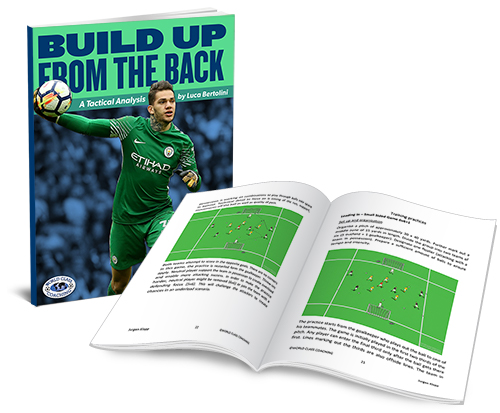
Table of Contents
PART TWO
The Player Techniques and Tactical Skills Needed to Build Up From the Back
The Player Techniques and Tactical Skills Needed to Build Up From the Back
The available time for players of the team in possession, wherever the ball is being played, is always getting shorter, and the opponents are always getting closer and closer inside a space. The training sessions and methods are nowadays based on small-sided spaces, whatever the practices are (small sided games, rondos or position games); the consequence is an improvement of the technical skills of the players and of the speed of play (receiving and passing) and of the combinations among the players.
The increase of the speed and the shorter available time to play convinced the coaches to find principles of play to find forward spaces as quickly as possible, to think about how and where to open them, how to counter the pressure of the opposition through the numerical or positional advantage, how to play out in a weak area of the opponent formation after a possession phase in a strong side.
In modern soccer, counter-attacks can lead to a finishing phase in few seconds (the average is 5"/6"). The whole pitch can be used to follow the principles of play we talked about just above.
These are the reasons why building up from the back from the goalkeeper and one's own goal is not less risky than a possession phase in the middle or final third. One these principles of play strategically on the pitch. For example, the beginning of the move invites the pressure of the opposition upward and creates useful spaces in behind the lines.
Sure, all the players are now asked to be skilled at the best level of their potential in regards to individual technique and tactic (how to escape a marker is an essential requirement), and have the best quickness possible.
Classic examples of players formation since the youth academy are the La Masia ones, who then were included in Guardiola's Barcelona FC 2008/2012 team. All them were coached and grew up with the proper technical skills to manage, to pass and to receive the ball under pressure and to build up from the back. That team was not an accident; that team was created through the years, and those years are the late '90s, just after the change of goalkeeper rule.
Let's see it in details:

All these players are those who were more involved in the build up process of the best team ever, from this point of view (among other categories): the 2008-2012 FC Barcelona. Their technical skills, in this first phase of play, fit at the best possible level the required steps to build up and play out from the back: being an option for the goalkeeper, finding a free teammate, and creating and exploiting numerical advantage in a specific area of the pitch, where the team wants to go forward.
The main technical skills the players are asked to demonstrate, are:
The goalkeeper must be good at playing with both feet and with proper distribution; he has to be always ready to receive with the right body positioning. Ederson Moraes, Man City goalkeeper, is the best example nowadays.
He can play as support teammate to circulate the ball through (he seems to substitute for the midfielder dropping back, e.g., Fernandinho, who can stay placed higher...
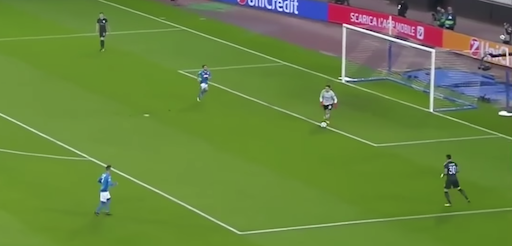
...and he is able to distribute to the teammate breaking through the lines of the opposition pressure, even in front of the goal...
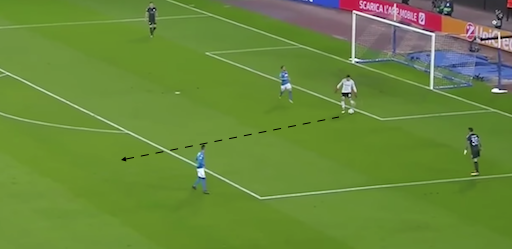
...similarly, he is able to be part of position games (as lower vertex here) inside the match.

The center backs must be able to receive and pass quickly inside the first third or out of it, to overcome the opposition pressure.
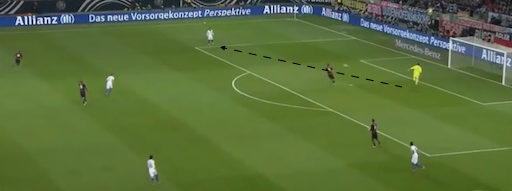
Two forwards are pressing the build up phase; two center defenders and the goalkeeper create a 3 v 2 duel.
The center backs must be able to overcome the pressure and play out to advance on the field.
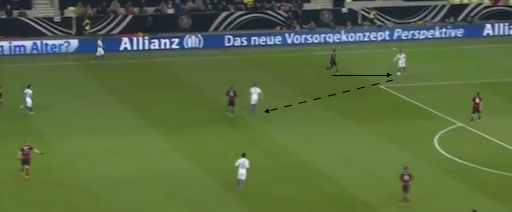
The center midfielder must be always placed near the ball to be an easy passing option. They must be skilled for one touch play....
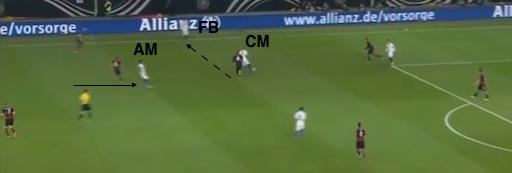
...or to switch the side toward a weak area of the opposition.
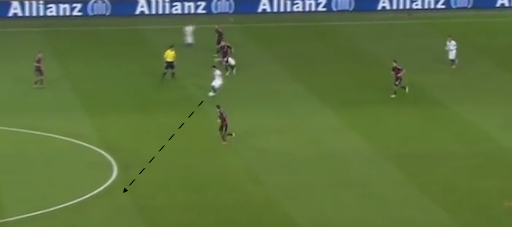
The advanced midfielders must be unmarked along the passing lanes and in behind the opponents.
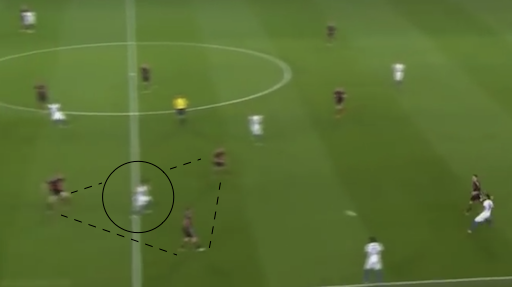
The fullbacks must be placed high on the field to support the move in the middle third; they must be unmarked and they must take part to the attacking phases.
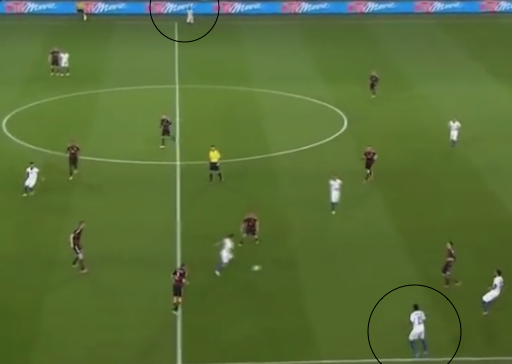
The forward must move toward the strong side to support the move, to create a strong side and to open spaces in between the lines for the teammates...
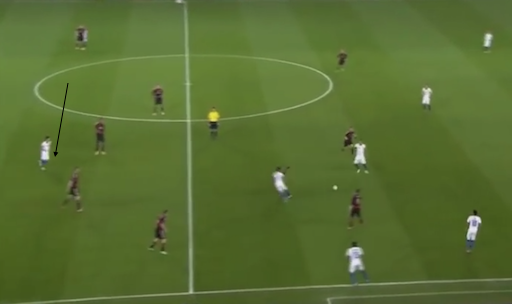
...or to create a deep weak side where the fullback can receive after a switch of the side.
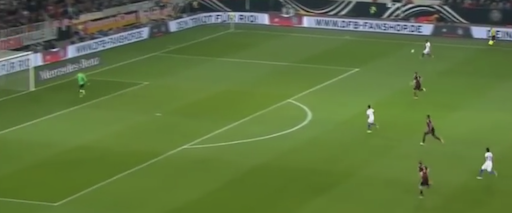
As far as tactical requirements to build up from the back, the basic player skill is to escape the marker or to be able to play under pressure with the right time and passing in the right space. The team must use positioning, through mobility, to create numerical advantages on the ball to play out.
Bielsa theory about how to escape the marker consists of five types of movements. The player who must receive the ball needs to be able to do these movements. These are described below.
1) Move to receive a pass and turn around with one touch control or dropping back, straight on or along a diagonal path and then turning around to go forward.
The player must run away from the marker or the pressing opponents, but with an open body shape to go forward with the following pass or dribble and to give continuity to the pattern of play.
In this first example, the center defender receives from the goalkeeper but he is under pressure of an opponent.
He then moves a little away from the pressure direction, he receives with an open body shape, looking at the pitch in front of him and he turns with one touch toward the fullback by his side, passing the ball wide on the flank. This way a first line of pressure is usually overcome.
Quickness and ball touch and body shape are the key points to keep the possession safe.
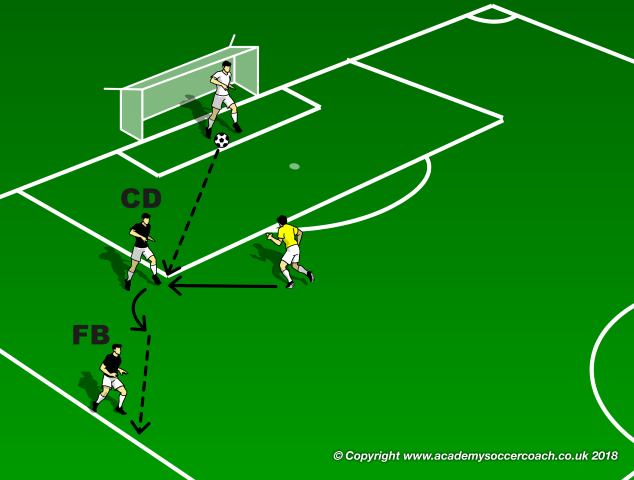
In this second example, the move didn't start from the back, but the team must play out from the back because it's under strong pressure. The goalkeeper is in possession and the center midfielder receives under pressure at the back.
The receiver is able to get a little away from the marker, finding time and space for a one touch control to turn and to play forward and wide onto the fullback's run. It's very important to cover the ball with the body to avoid tackles and loss of possession; two touch play or back passes can be easier solutions if the pressure action creates risky situations.
Here again a first line of pressure is usually overcome; two players might be used in case of ultra-offensive pressure of the opposition.
Ball defense, body shape, and technical skills are the key points to keep the possession safe.
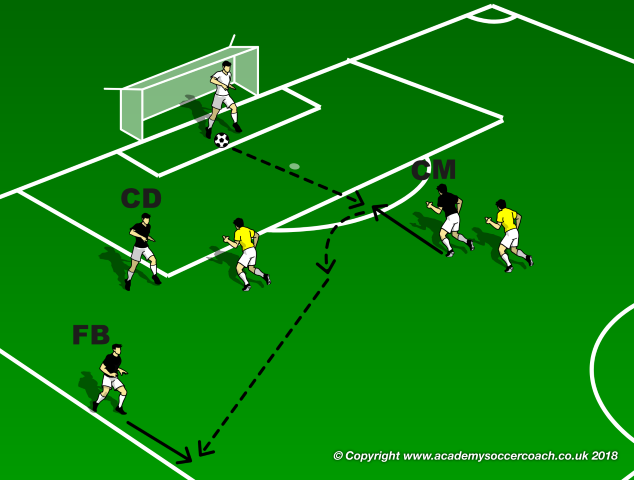
2) Move to receive behind the opponent with the right timing of run and pass, from the flank toward the depth, from the center toward wide spaces or in behind the opposition lines
It's possible, when the opposition is pressing the player of the possession team strongly and closely to run away at the back and to receive behind them. The closer the defender is, the easier the potential receiver can get free from him at the back.
The sequence of runs may be summed up with an L movement with different speeds; get closer to the opponents slowly (moreover if the freeing player is a forward) and then straight to the objective as fast as possible, to gain space and time before the defender can turn.
In this first example, where the possession team must play out under pressure, the fullback escapes from the marker at his back and toward the center to create a potential numerical advantage in the middle, as inverted fullback for example, receiving the pass of the dropping back center midfielder.
This is a more complex 3 player combination (the fullback can be considered a 3rd man) and all the timing of passes and runs must be perfectly linked to avoid the loss of possession.
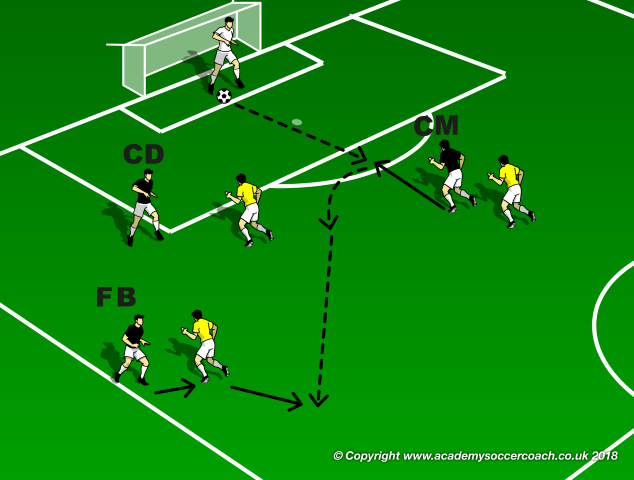
This second example can be considered as a play out progression of the previous picture; the fullback receives in the middle, but he's put under pressure of two opponents. He then passes back to the right midfielder.
The right center midfielder is under pressure too, but the opposite teammate (LM) exploits his forward run to escape at the back and he receives a pass over the second line of pressure. This is situation is quite favorable for the team in possession, as the ball is received with nearly half of the opposition field player, who are supposed to run toward the opposition goal.
Again, this is another 3 player combination (the left midfielder can be considered as a 3rd man) and the timing of the passes and runs must be perfectly linked to avoid the loss of possession.
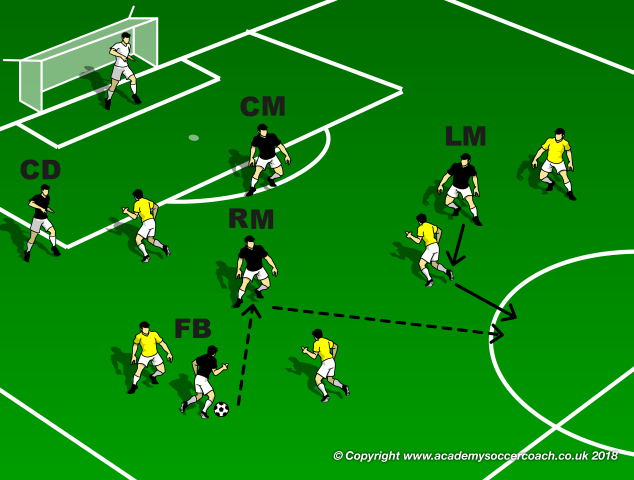
3) Move to receive along a path by the opponent's sides, generally between two very close to each other, or by the a defender's side, getting away from him if it's not possible to receive behind him
Here, the forward gets closer to the defenders, who are closing him, and, if possible, he receives between and over them, by their sides, on the run. This would be the ideal situation to progress on the field, as it's the best sequence possible for counter-attacks.
In this example, the right fullback is in possession but under pressure. The right midfielder is able to overcome the line between two defenders, running by their side and receiving over them.
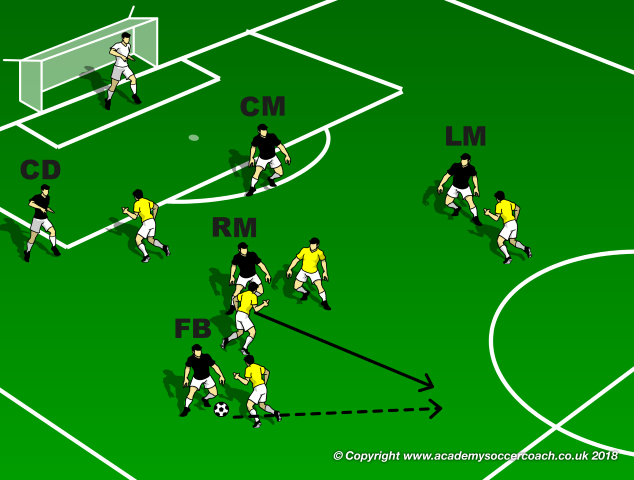
When progressions between the defenders or to free from the marker behind him are not possible solution, the best choice is to escape the marker by his side.
The potential receiver must get away along a diagonal imaginary line as he is close to the opponent, trying to create enough space to prevent him from tackling, but without losing the vertical line that leads toward the following objective (forward pass or dribble) as the ball is received, while the defender tries the anticipation or the interception.
In this example, the right midfielder passes back to the center one, who is moving forward after the first phase of the building up; meanwhile the left center midfielder moves away by the direct marker's wider side, to create enough space to receive and play forward.
It's very important to start moving one pass before the ball has to be received, to link the timing with the second teammate. The prior pass gives the sign of counter-movement; the second pass must be received already unmarked and away from the opponent.
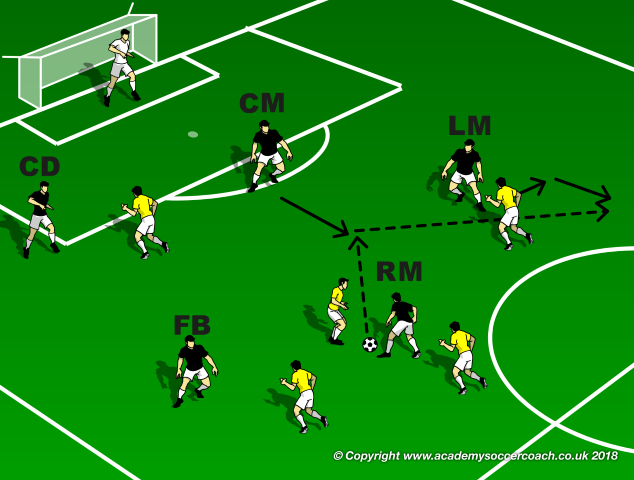
4) Move to receive and counter the opponent's anticipation
The forwards runs close to the defender to receive ahead of him and he overcomes with (usually) one touch control, moving toward the opposite direction of defender's run.
The first objective of the player who receives this way must be to anticipate the defender, who is trying to anticipate him as well. This movement is useful to gain time against the nearest opponent.
In this first example, the fullback runs inside to receive a pass from the right midfielder, stealing the time to the direct opponent who is trying to anticipate him.
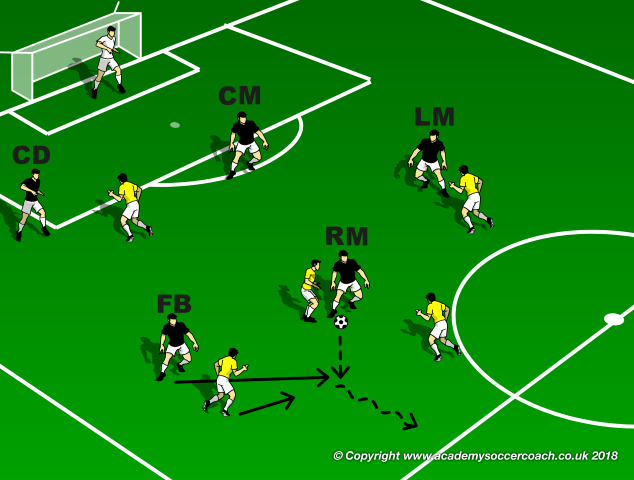
Reaction speed and sprint are necessary to win the ball against the defenders, as well as a good first touch at speed to gain space from him, to maintain the possession, or anyway, not to lose it against other defenders, as the ball is received.
In this second example, the fullback is in possession, but the nearest passing lanes toward the winger and the right midfielder are closed; all the players in possession are under pressure in a duel 3 v 3, as the attacking team could not create numerical advantage while building up.
The winger's run to anticipate and get free from the nearest opponents, while receiving from the fullback, creates positional advantage for the right midfielder, who can dribble forward leaving his direct opponent behind him.
As the winger receives, he must be able to avoid the double marking of a potential second defender and he must pay attention no to lose the ball, as the opposition ball carrier could easily face the penalty area and the goal.
The timing of movements and the technical skills to manage the ball at speed and under pressure are key points for the players in possession to carry out this kind of combination.
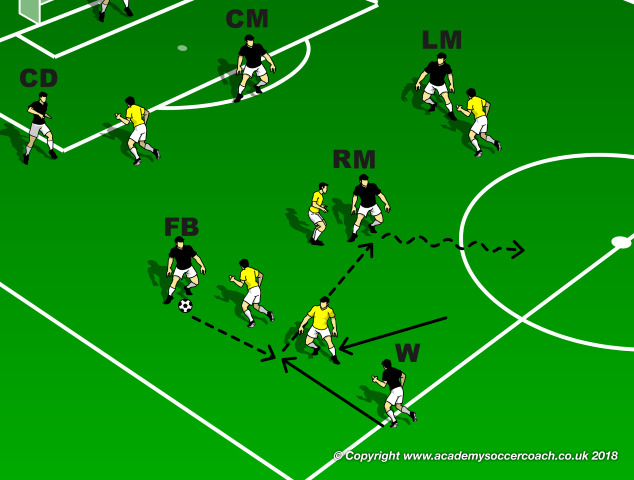
5) Move to receive a volley pass on the same line of the opponent
Forward and defender are playing on the same line; the forward drops back to invite his opponent out of his position and then he runs toward the space at the back of the opponent, as soon as he can see it.
The semicircular movement must be wide enough not to receive offside, and to give time to the player in possession to send the volley pass.
The attacker must be positioned with the right shape, before receiving, to keep the positional advantage and to face the opposition goal.
In this first example, the defense line is under pressure, the fullback drops back and wide to open a passing lane and to be an easy option for a forward pass; this way, the possession team doesn't lose space on the field.
The right midfielder and his direct marker are placed on the same line and the midfielder escapes him as already explained to receive a forward volley pass from the back, overcoming two pressure lines and giving him the chance to face the opposition goal.
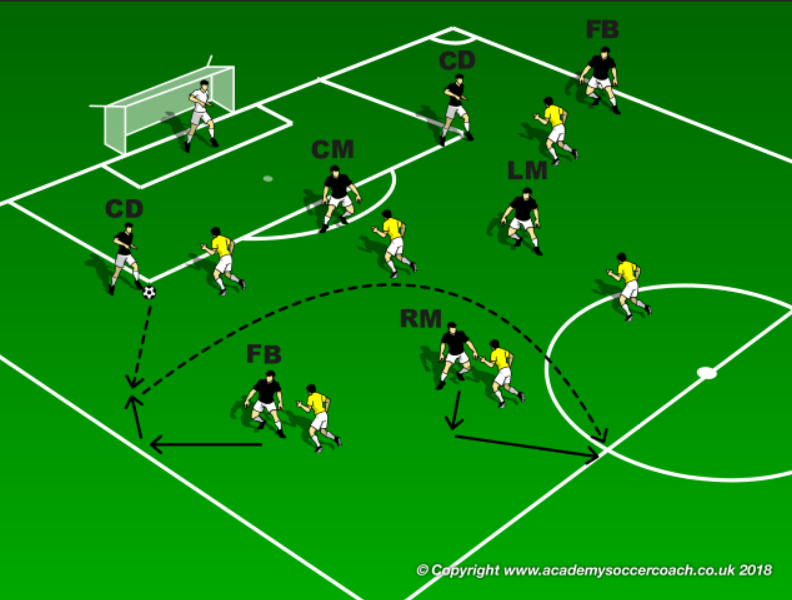
How do we synchronize all the players to play from the back successfully?
The player who sends the pass must be able to control the timing, the speed, the direction and the type of ball touch to give his teammate a positional advantage when he receives.
" If the timing and the direction of the pass are not correct, the teammate doesn't receive the ball and it means the loss of possession in the specific move. It could be recovered with a throw-in, for example, but the danger of the move is lost
" If the pass is too slow or too fast, an interception of an opponent is very likely
" If the type of pass is not good enough, the teammate will lose time and space while receiving, giving the opponent enough time to recover the position, to put pressure and to win the ball
The receiver must be able to control the timing and the speed of run without the ball, in relation to the tactical situation (teammate, opponent and space).
" Early runs create a situation where the player is out of position when the ball should be received
" Late runs lead to the loss of potential advantages (including positional), against the direct opponent; the consequence is to be under pressure or even man on man marked
" Changes of rhythm, speed and direction are important key points, because they could surprise the opponents and to create a positional advantage.


